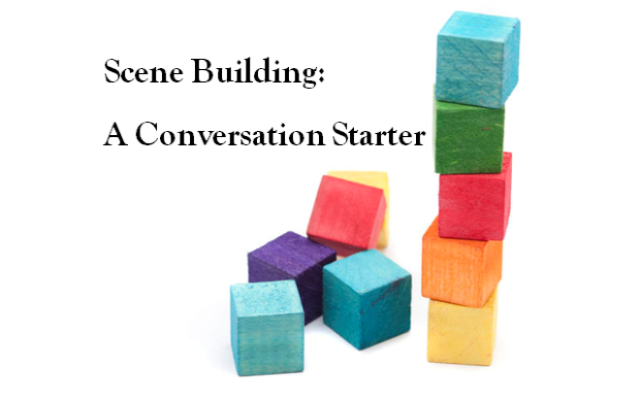Users Who Spiked

SCENE BUILDING: A CONVERSATION STARTER
Private Notes
Private Notes
Notes
Last week I naively sat down to outline and draft a short story to share with you fine folks, only to come up, well, short. I know this has happened to every writer I know personally, and I’m sure I’m not the only one on this website who, despite the best laid plans, can’t seem to find the right words.
Though it may be a controversial opinion, I do not believe in writer’s block. I believe that if you can’t write, there’s a reason it’s not working. Luckily, user Adam on WriteSpike had brought up scene building on my last post, and it came to mind as I struggled to begin my story. I had my characters and their actions as a group, but I hadn’t broken out their motivations. Enter scene building.
I want to briefly preface this by saying that there are many, many articles you can find on Google regarding the basic structure of scenes. I’ll highlight those below. My main point in writing this article to suggest that if you don’t often outline your scenes according to these structural guidelines, and you’re having some trouble writing, maybe this would be a good place to start. For me, anyway, it seems that often one or more of these pieces is missing and causing the trouble. I hope to hear comments about your own experiences with scene building, particularly as it pertains to facilitating your writing progress, as well as anything specific you might want covered in more depth.
Since my short story is just for fun, I’ll use bits of it here for our examples. Please don’t judge too hard – I was mostly just having a good time with it!
Basics of Scene Structure
For every action, there is an equal and opposite reaction. Or, in the case of writing, there is an incredibly unequal and definitely opposite reaction. Actions and reactions create conflict, and conflict creates movement. Since I try to keep my stories going somewhere, everything checks out.
Goal: What does your character want?
Conflict: What prevents her from getting what she wants?
Disaster: When she attempts despite adversity, how can it go wrong?
Reaction: What does she immediately do when faced with failure?
Dilemma: What is preventing her from rectifying the situation?
Decision: What does she decide do to about it?
Every scene doesn’t necessarily need all of these pieces, and therefore they may not always be in this order. It’s the most helpful and logical, but I find myself often beginning closer to the disaster/reaction/dilemma area instead of with a goal.
In and of themselves, the building blocks of a scene are incredibly useful. They give structure and meaning to interactions that might otherwise be lacking. I would argue that even more than that, they force you inside of a scene in a unique way. Let’s have an example:
For my short story, I wrote out brief character descriptions. I have copy/pasted them directly from my draft so that we’re all on, literally, the same page.
Stellan is a male fighter who fears melee, yet insists upon using a sword. He is a bit jumpy. Aged about 20. Looks like Prince Charming and totally cliché, no scars or anything. Pristine armor, blonde hair, classic good looks, charming personality. Total sissy in battle.
Gemma is a female thief who is hard of hearing and thus incredibly loud. She doesn’t realize she has this problem. Aged about 17. Adorable red-head, rough around the edges and kind of morally gray, but generally loveable.
I also wrote block descriptions of each scene of the story, and then had planned on just starting to write and see where it took me. Here is my basic description of Scene 1.
Scene 1: They begin in jail. Gemma is in jail because she got caught. Stellan is one of the guardsmen. She manages to convince him to help her after watching him get bullied by a senior guard. She thinks the guard is just being mean, but finds out the hardest way possible that he actually is a terrible swordsman.
Sounds workable, right? Except when I sat down to write, I realized that I had no idea whose point of view I should start with, or, more importantly, why. I didn’t know how Gemma convinced Stellan to help her, or why he agreed, or how his interactions with another guard played out and worked within the story. So I broke everything out, and the scene started writing itself.
Reaction: Gemma is unphased by her failure. She is confident she can bounce back. A tad sarcastic about it though.
Dilemma: She is stuck in jail, and likely to lose at least her hand. She needs to escape before things escalate any further. She decides also to rob this king blind, since she can’t return to the kingdom anyway.
Decision: In the middle of her dilemma, a solution presents itself in the form of her guard. Stellan is apparently considered less than by his peers, and she decides to play on that insecurity to gain his aid.
Goal: Get Stellan to help her escape the prison. Trick him into robbing the treasury on the way out.
Conflict: They must get past the guards on their way out. Stellan is a terrible fighter.
Disaster: Stellan reverts to his old self and leaves her to fend for herself when melee becomes a reality.
You can see how, just from the tiniest bit more planning (it literally took me minutes to plot out that scene), an incredible amount of depth was added. The character actions have more meaning and the motivations are clear. I can now visualize the scene playing out, and just need to describe it to you, the reader. It was clear pretty quickly that Gemma had the most at stake in the scene, and so her point of view was the one to take. From there it was easy to tease out how she might feel and what she might want at this particular point in the story.
Have you ever resolved a sticky writing situation using scene building principles? What about it did you find most helpful? Do you always break down your scenes before writing, or only when they are troublesome? I’m interested to hear how everyone uses this writing tool, and if there’s anything I can write about to help you further.
Comments
Please login to post comments on this story
-
Elizabeth, this is great information. I have used an outline for the second in my series, however, have not tried building blocks like this. I will have to use this information to help me get past the hurtle my hectic life has caused lately. My mind just seems to wonder in 50 places at once and then back to my storyline. Thank you for sharing.
-
Very helpful! Thanks for sharing!

















